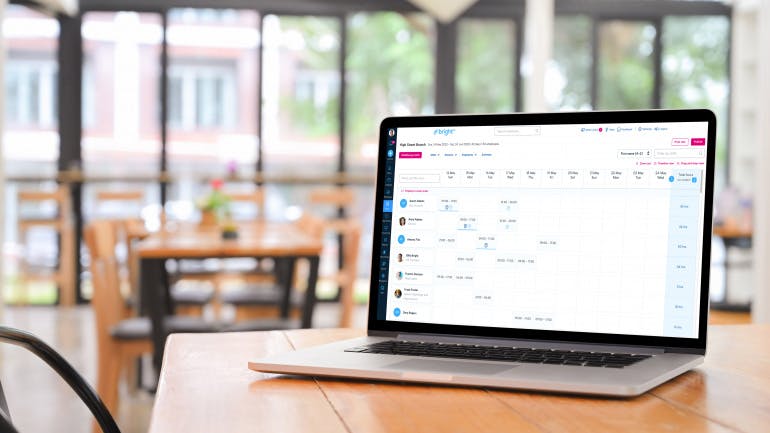First published on Friday, June 28, 2024
Last updated on Monday, July 1, 2024
Traditionally, managers schedule shifts patterns based on expected workload and employee availability. However, assigning shifts weeks or months in advance can lead to challenges when unexpected staff absences or increased customer demand arise. It can be difficult to arrange short-term cover, with under and overstaffing common.
Thankfully, there is another, more flexible, way. You can optimise staff management through the effective use of open shifts.
In adopting the open shift model you can realise benefits such as increased employee satisfaction and greater operational efficiency. We’ll discuss such benefits and the potential for open shift management with BrightHR's shift and rota planning feature here.
Understanding open shifts
Planning ahead is wise, but it’s not always possible to assign every shift in advance.
Establishing employee availability and willingness to cover takes time. Instead, you can share the rota and allow staff to claim shifts on a first-come, first-served basis. This will allow you to better cope with demand fluctuations, absences, and varying workloads without putting too much pressure on current staff.
Benefits of open shifts for business owners
As mentioned, the allocation of open shifts can save you considerable time as a business owner. It also makes for greater flexibility, with staff able to claim whenever a shift opens up that matches their skills and availability. This can lead to greater satisfaction, productivity, and company loyalty. It can also help in the attraction of talent, given the focus on having a desirable work-life balance.
Unpredictable factors like seasonal changes, market conditions, and unexpected events make demand forecasting difficult. For example, a restaurant might get a rush after a glowing review or see a drop-off when a new competitor opens. In offering open shifts as and when required you can ensure the maintenance of adequate staff levels.
If you adopt the traditional scheduling method then a sudden spike in demand could force you to recruit temporary workers or pay your in-house team overtime. On the other hand, you could make savings in arranging cover through open shifts. This will allow for the optimum use of staff resources, boosting operational efficiency.
Implementing open shifts
HR tools and technologies such as BrightHR’s staff rota software simplify the management of open shifts. Our staff rota software has an open shift feature that removes the stress of dropped shifts and last-minute no-shows. Open shifts can be quickly scheduled, with notifications sent out to suitably qualified staff. In offering such shifts on a first-come first-served basis you can avoid any claims of favouritism.
Once a shift has been claimed the staff rota automatically updates, closing availability to other staff members. It allows you to save time through the rapid allocation of shifts, allowing for any changes in demand. Your employees are also bound to appreciate the opportunity for increased earnings given the cost-of-living crisis.
Open Shift challenges
There are several challenges to be aware of when it comes to the assignment of open shifts. For instance, you can’t be completely confident of each shift that opens being claimed. This will be a particular issue if you depend on the filling of multiple open shifts. If there’s any concern over business continuity then you might opt to set more open shifts than you expect will be needed. You could also share open shifts with a temporary staffing agency.
If your established staff are used to more traditional scheduling methods then there’ll likely be some resistance to the setting of open shifts. The predictability of income might be a worry if hours can be claimed whenever a shift opens up. This can cause stress and dissatisfaction, with staff considering alternative employment choices.
The take-up of open shifts will depend on the employees’ level of commitment and balance of work-life priorities. There will be a risk of understaffing, given the reluctance to make plans in the hope of securing an open shift. This risk may be increased during periods of good weather or when there are highly demanding tasks that employees would rather avoid. If shifts can’t be filled then any active employees are likely to be overburdened, with a potentially negative impact on customer satisfaction and revenue.
What’s more, there’s no telling that the staff who take up the open shifts will be the best qualified. They might not have been given relevant training or be familiar with the available resources. On the other hand, mistakes could be made in the staff member’s desperation to impress and secure future shifts.
The setting of open shifts should also account for country-specific regulations and employment laws. As an example, employees must be particular notice of work schedules in the USA and Canada. There are also strict rules on the setting of work hours and rest periods in the European Union.
Shift setting recommendations
You can effectively overcome the open shift challenges with smart strategies and guidelines. This should begin with open communication and we have a guide on the various styles of comminication to help, ensuring that employees are aware of your business needs and the availability of shifts. You can set up real-time notifications to alert your workers whenever shifts become available. You’re also advised to ask for feedback and make adjustments to the shift setting system for worker satisfaction.
Here are some ways of ensuring fairness in the setting of open shifts:
- Setting a deadline by which shifts have to be selected
- Giving training to ensure that all employees know how to use the shift system
- Limiting the number of shifts that any single employee can take up in a given week
- Setting criteria (such as the required level of seniority and availability) for specific shifts
- Allowing for shift swapping with management approval
- Recognising and rewarding employees who regularly take on less desirable shifts
How BrightHR can help you with open shifts
Offering benefits such as increased flexibility, productivity, and worker satisfaction, open shift setting stands out as an alternative to more traditional methods.
However, it’s important to be aware of the drawbacks and ensure the fairness of open shifts according to employee needs and preferences.
Get set to explore the potential of open shifts and take your workforce scheduling to the next level with a free demo of BrightHR’s staff rota software.










